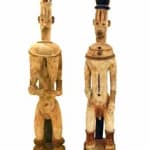African Art / Pair of Urhobo Painted Wooden Shrine Figures (Edjo), 19th Century CE - 20th Century CE
Painted Wood
81
PF.6100
Further images
These monumental sculptures were created by the Urhobo tribe that inhabits a region in Southeastern Nigeria next to the Igbo tribe. Originally, they would have been placed within a shrine,...
These monumental sculptures were created by the Urhobo tribe that inhabits a region in Southeastern Nigeria next to the Igbo tribe. Originally, they would have been placed within a shrine, either as freestanding idols or as supports for the building structure. Similar figures either represent tutelary gods or deceased royal ancestors whom were believed to play an active role in the daily lives of their descendants from beyond the grave. In either case, they personify the forces of life over which we have no control or comprehension. Their high-ranking status within Urhobo society can be ascertained not only from their tremendous stature but also from the elegant jewelry that decorates their body. Much as medals signify the rank of a military leader, jewelry and bodily scarification was reflective of one’s place within the tribal hierarchy of many African peoples. The thick collar bracelets and anklets that adorn both figures, as well as their necklaces, reveal their nobility. Their elite status is further enforced by the scarifications present at the join of their ears and by the fact that they are sitting on stools, the penultimate symbol of rank in Africa. Most likely, this pair represents a benevolent royal couple memorialized in the form of these painted wooden statues so that they might continue to rule from beyond. Their prestige and benevolence are also dictated by the forms of the sculpture. The fantastically exaggerated breasts of the female figure reveal her fertile nature. She suckles the young child in her lap, as her spirit will continue to nurture the villagers even after her physical death. Meanwhile, the sex of the male figure is also amply depicted as he holds a tubular shaped object in his hand. Perhaps a staff of some kind, this object no doubt is a tangible manifestation of his authority much like a baton de commandment. The colorful paint applied to the sculptures reveals the respect and admiration that the villagers paid this royal couple. These massive sculptures tower over us like spiritual guardians guiding our course through life.







